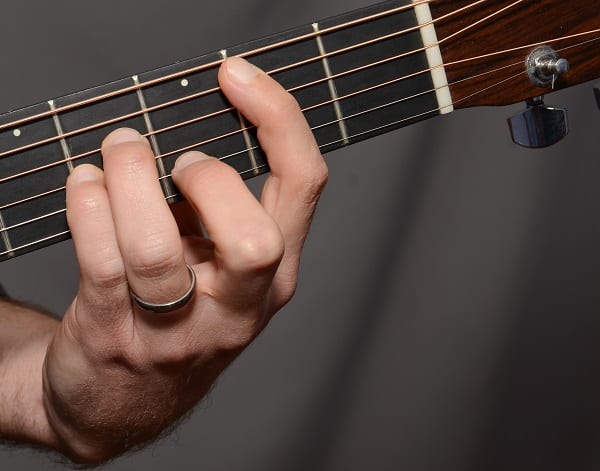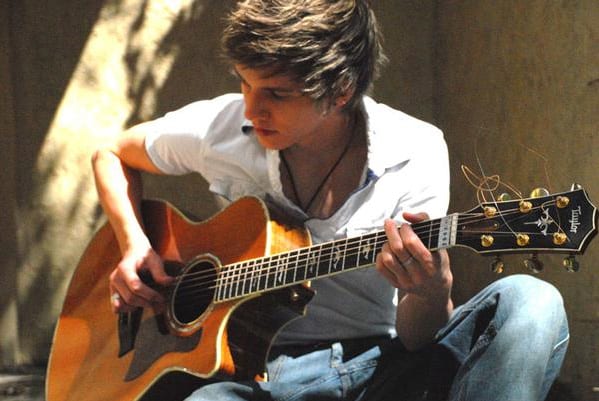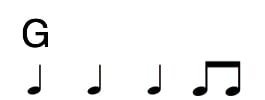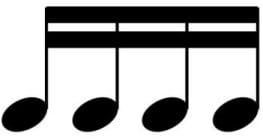Looking for rhythm guitar lessons? You’ve come to the right place!
In this free guitar lesson you will learn:
- 2 strumming hacks that will make your guitar chords come alive.
- The no1 secret to staying in time.
- Guitar chords for beginner, intermediate and advanced guitarists.
- 3 quick & easy strumming patterns that enhance your rhythm & musicality.
Over 100,000 guitar-learners get our world-class guitar tips & tutorials sent straight to their inbox:
Click here to join them
Get our best guitar tips & videos
Let’s get started!
Rhythm Guitar Lessons: What Is Rhythm Guitar?
Rhythm guitar, in brief, is a style of guitar playing where we strum chords rhythmically rather than play single note melodies or solos.
Rhythm guitarists and lead guitarists are not necessarily mutually exclusive. Sometimes, two guitarists in a band might swap roles depending on the song, or sometimes one guitarist may play a bit of both within one song.
Whatever the set-up is though, to play rhythm guitar is to strum chords rhythmically.
Rhythm Guitar Lessons: Chords
If we’re going to strum chords rhythmically, we need to know some chords.
Rhythm Guitar Lessons: Beginner Chords
The best chords to start off with are the basic open chords, you can learn these chords here: Easy Guitar Chords For Beginners
These chords pop up all the time in music in a wide variety of genres, so whatever type of rhythm guitarist you want to be, be it a folk rhythm guitarist, a rock rhythm guitarist, a pop rhythm guitarist or a blues rhythm guitarist. You must know these chords.
Another type of chord beginners should have a look at, once they’re happy with their basic open chords is power chords.
Power chords are small, stubby chords that only contain two notes. These are essential for any rhythm guitarist looking to play punk, metal or rock.
To learn power chords, go here: How To Play Guitar Power Chords
Learn 12 EASY beginner chords with our popular guide


Where should we send it?
✅ Stop struggling. Start making music.
✅ Learn beginner-friendly versions of every chord.
This is our most popular guide and it will improve your chord ability quickly! 😎
Get your own personalised guitar-learning plan 🎸
Get a custom guitar-learning plan here: Click here for GuitarMetrics™
World-Class Guitar Courses 🌎
Learn from the world's best guitar educators: Click here for our guitar courses
Rhythm Guitar Lessons: Intermediate Chords
Once a rhythm guitarist has gotten to grips with basic open chords and power chords, there’s some more advanced chords they can learn. These are barre chords.
Barre chords are chords where one of our fingers press more than one string.
- To learn more about barre chords, go here: Barre Chords: The Ultimate Guide
Barre chords are quite tough when compared to normal chords, so take your time and don’t be put off.
Rhythm Guitar Lessons: Advanced Chords
There’s a lot more to chords than just majors and minors.
There’s a wide array of different chords available to us such as:
- Dominant 7’s.
- Major 7’s.
- Minor 7’s.
These are the sort of chords you might well find useful if you’re aspiring to play rhythm guitar in styles such as blues, jazz, funk etc.
- We cover these sorts of chords in this article: Jazz Guitar Lessons: A 5 Step Program For Rapid Progress
Remember, these are called advanced chords for a reason. Don’t attempt them until you’re totally happy you can do both the beginner and intermediate chords.
Want free guitar tips and video lessons delivered to your inbox?
Join over 100,000 guitar learners and subscribe to our guitar-tips-by-email service. (It's free.)
We'll send you a series of lessons that will move you to the next level of your guitar journey.
Learn how everything fits together quickly, easily and effectively. We share ninja tips (for instant fun!) but also timeless fundamentals that will deepen your understanding.


Get our best guitar tips & videos
Our Guitar Courses
To become a better guitarist click here to see our guitar courses
Get your personalised guitar-learning plan 🎸
Want us to make a guitar-learning plan that is customised to you? Click here for GuitarMetrics™
Rhythm Guitar Lessons: Strumming And Musicality
In order to be true rhythm guitarists, we need to put some rhythm into our guitar playing. We do this by strumming.
Much as with chords, there are beginner, intermediate and advanced ways to strum.
How we strum will also depend upon the style of music we’re playing.
Rhythm Guitar Lessons: Beginner Strumming
For some reason, a lot of beginner guitarists tend to be baffled by strumming. They have a tendency to overthink it.
There’s really only two types of strumming in rhythm guitar playing, these are
- Downstrokes.
- Upstrokes.
What’s best to do is to pick one of your beginner chords and try strumming it down and up, down and up, down and up.
This should hopefully demystify strumming a bit for you.
One important thing to note though is that if you want your chords to sound bold and clear rather than muddy and faint,you must use a guitar pick.
Don’t strum with your thumb.
As well as sounding muddy and faint, it’s practically impossible to do an effective up-stroke using your thumb.
For a quick and simple explanation of how to hold a pick, check out this article: How to hold a guitar pick in 3 easy steps
Here’s a quick audio demonstration of what repeatedly strumming down and up should sound like.
We’ve used the Em chord here because it’s a pretty simple chord and it uses all six strings.
What if the rhythm is more complicated than just down, up, down up… ?
Obviously not everything is going to be that simple.
The way a lot of rhythm guitarists figure out the strumming pattern of a song is by listening to it and copying it by ear.
But if you find that a bit difficult, another approach is to read the rhythm.
Are you familiar with the children’s song ‘Run Rabbit Run’?
This song is a perfect example of how rhythm works.
Here is the song lyrics written out with the rhythm written underneath:
Notice that the word ‘run’ is a one syllable word, and has a single note symbol written under it.
The word ‘rabbit’ is a two syllable word and has a double note symbol written under it.
The single note symbol is called a crotchet or a quarter note and for our purpose here means we play one single down strum on the guitar.
The double note symbol is a pair of quavers or eighth notes and it means we play a down stroke and up stroke.
NB: Don’t worry about why these note symbols are called crotchets or quarter notes or quavers or eighths. What’s more important at this stage is knowing what to play when we see them.
So we could change the lyrics of ‘Run Rabbit Run’ to ‘Down Down-up Down’… and play the rhythm of it using a G chord.
Here’s a quick audio demonstration of that:
So, if we look at an exercise like this:
… we can read it as: “run run run rabbit” or “down down down down-up” and play that rhythm on the guitar.
Rhythm Guitar Lessons: Intermediate strumming
One thing that you may well notice if you listen to different styles of music is that while they may often feature rhythm guitar, the way it is played can vary quite a bit.
NB: No matter what style you’re playing, if you’re a rhythm guitarist you must be sure to play in time. Pay close attention to what the drummer and bass player are doing and be sure not to go faster or slower. Practicing with a metronome will help: Free online metronome
Root note, then full chord (Country strumming)
Let’s use a G chord for this exercise.
It can be either your basic open G chord or the barre chord at the third fret. Either will do.
Instead of playing four down strums or alternating between down and up strums, what we want to do is play just the sixth string (the thickest one) on the first and third beats and strum the whole chord on the second and fourth beats.
Here’s a quick audio demonstration of that to help make things clearer:
Have a go yourself. You can even try it with different chords!
Let’s try another technique.
Palm muting (Rock strumming)
Remember those power chords you looked at earlier. Power chords sound awesome when played with a technique called ‘palm muting’.
Let’s try using the A power chord (A5) for this exercise.
To palm mute, what we want to do is bring the palm or the heel of the strumming hand onto the the strings slightly so that it mutes them slightly.
The important word here is slightly.
Bring the hand too much onto the strings and it will mute them completely, meaning we get nothing but dead string noise.
Here’s a quick audio demonstration of what palm muting should sound like:
The reason we’ve used power chords here rather than full chords is because palm muting seriously limits how much we can move the strumming hand.
You can try putting a barre chord on instead if you like, but you may well find that it’s only the power chord bit of the chord (ie. the lower couple of strings) that will sound, so all that effort barring down all six strings won’t count for much.
To learn more about palm muting, go here: Palm Muting: An Essential Guide
Let’s try another technique:
Off-beats (Reggae/Ska strumming)
Caribbean music is quite unusual when compared to most types of rock/pop music that are popular in the Western world. In this music, the emphasis is on the off-beat rather than the on-beat.
“What’s an off-beat?” you might ask.
The off-beat is simply the ‘and’ of the beat rather than the ‘one’, the ‘two’, the ‘three’ or the ‘four’.
If a beat goes: “One and two and three and four and…” the off-beats are the ‘ands’.
Here’s an audio demonstration of what it sounds like when we only play the ‘ands’ using an A barre chord:
For this exercise we’re using an up-stroke on each ‘and’. No down strokes.
We want to hear the nice trebly top bit of our chord, not the chunky, punky power chord bit of the chord.
Give it a go.
You can try it with different chords if you like.
If you play it slowly, it will sound like reggae. If you speed it up, you’ll get more a of a ska sound.
Now let’s try…
Passing notes
Passing notes are simply notes that we add in as we pass between two chords on the guitar. They’re a great way of adding a bit of flavour to our rhythm playing.
Let’s say we’re changing between G and Em.
We could add a sneaky F# note in there to make things a bit more lively.
The F# note is the second fret on the sixth string.
Here’s a tab of this exercise.
You’ll notice that it’s a bit of a variation on the country strumming pattern we looked at earlier.
Here’s what it exercise should sound like:
If you’re feeling a bit adventurous, you might want to apply a bit of palm muting to those sixth string notes to give them a more percussive, kick-drum type tone.
Now let’s try…
Hammer-ons
A hammer-on is:
- When we hammer one of our fingers down to produce a note rather than plucking it.
If we play our basic C chord for example, but lift off the second finger, strum the chord, THEN hammer our second finger down, we should hear that note of the chord arriving slightly late.
Even though we’re playing rhythm guitar, not lead guitar here, this will give us a very melodic sound.
Here’s an audio demonstration of this exercise:
We’re doing the hammer-on on the first chord of each bar. The other chords are just played normally.
This works with a lot of our basic open chords. Try it out with a few of them at see what sounds you get.
Rhythm Guitar Lessons: Advanced strumming
Remember the ‘runs’ and ‘rabbits’ we looked at earlier?
We want to introduce a new rhythm-word into our vocabulary:
Caterpillar.
Caterpillar is the word we say (and play) when we see this written:
We play a caterpillar (AKA four semiquavers) with a fast down-up-down-up strumming motion.
Let’s try and play a whole bar of caterpillars using one of our advanced chords: Em7.
Now…
Let’s see if we can make this exercise sound a bit funkier.
Left-hand muting
For the first two syllables of the word ‘caterpillar’ (‘cater’) we want to have our chord pressed down, BUT, for the second two (pillar) we want to lift the chord off slightly so as we’re still touching the strings, producing a percussive sound.
Here’s what this should sound like:
We could also try…
Sliding
Sliding is basically where we play one chord or note and then slide it across the fretboard so as it becomes another chord or note.
This will also give us a funky sound.
In this example, you are starting on a G barre chord on the 3rd fret, and then sliding to an A barre chord on the 5th fret.
See if you can figure out the rhythm by ear. If you can’t, don’t worry. Try improvising one of your own. It’s the slide that’s important here!
What Type of Guitarist Are You?
Take our 60-second quiz & get your results: Take The Quiz
Join the world's best online guitar school 🌎
- Get your own personalised guitar learning plan (customised just for YOU).
- World-class online guitar courses. Learn at your own pace.
- Community Campus & Learning Forum - A friendly community! Connect with our team & students. 😊
- Beginner Song library with chordsheets, tabs and tips. (Songs suitable for all levels!)
- Regular live streams, seminars and Q&A sessions - Learn from world-class guitar educators. Get all your questions answered!
Click here to learn more about National Guitar Academy membership 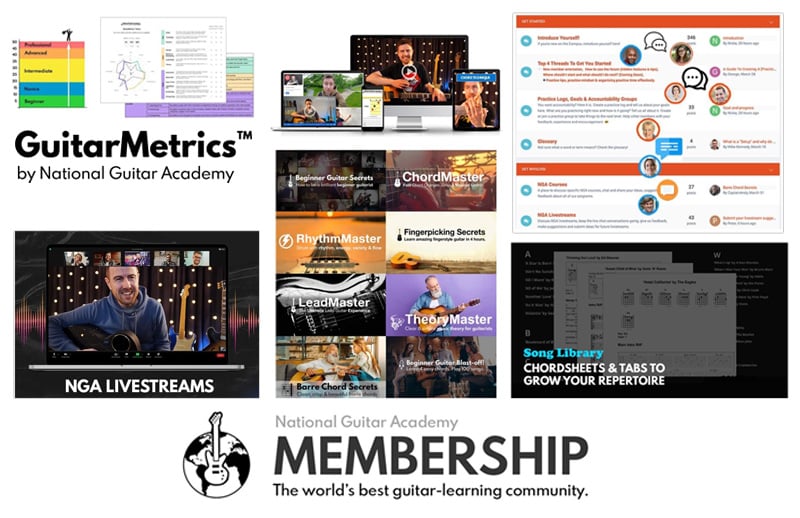
Cool Guitar T-shirts 😎
Look cooler! Check out our merch: Click here to see our merch store
Want free guitar tips and video lessons delivered to your inbox?
Join over 100,000 guitar-learners and subscribe to our guitar-tips-by-email service. (It's free.)
We'll send you a series of lessons that will move you to the next level of your guitar journey.
Learn how everything fits together quickly, easily and effectively. We share ninja tips (for instant fun!) but also timeless fundamentals that will deepen your understanding.


Get our best guitar tips & videos
Popular Lessons
How To Learn Guitar: An 11-Step Programme For Beginners
How To Choose The Perfect Beginner Guitar
More Cool Guitar Stuff
Learn about National Guitar Academy: About Us
Join us on Facebook for daily guitar tips.
Listen to our Learn Guitar Podcast for rapid guitar progress.
Check out our free chord lessons.



